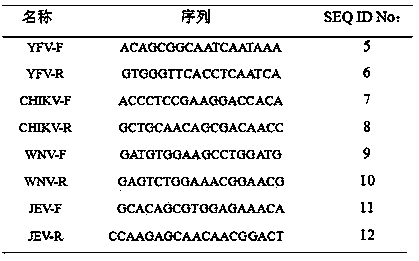Identification and detection method for yellow fever, Japanese encephalitis, chikungunya fever and west Nile fever, primers and probes
A technology for the identification and detection of Japanese encephalitis, which is applied in the determination/inspection of microorganisms, biochemical equipment and methods, and resistance to vector-borne diseases. Early diagnosis and other problems, to achieve the effect of fast detection, stable results, and large throughput
- Summary
- Abstract
- Description
- Claims
- Application Information
AI Technical Summary
Problems solved by technology
Method used
Image
Examples
Embodiment Construction
[0025] 1. Synthesize the required primer pairs and probes according to the nucleic acid sequences in Table 1, and biotin-label the 5' end of the downstream primer in each pair of primers; and aminate the 5' end of each probe And connected with C12 adjacent arm sequence.
[0026] 2. Coupling the probes with corresponding fluorescently coded microspheres respectively, and then mixing them in equal numbers to prepare a microsphere group coupled with specific nucleic acid probes.
[0027] Select 4 types of microspheres (BioRad) numbered 22, 39, 15, and 12, and perform coupling of nucleic acid probes as follows:
[0028] 1. Put the 4 types of microspheres numbered 22, 39, 15, and 12 stored at 2-10°C and 2 bottles of unopened EDC powder (10mg / bottle) stored at -20°C at room temperature for 30-60 minutes.
[0029] 2. The YFV-PF, CHIKV-PF, WNV-PF, JEV-PF nucleic acid probes were respectively used ddH 2 Dissolve O at a concentration of 0.1 nmol / μL;
[0030] 3. The four kinds of m...
PUM
 Login to View More
Login to View More Abstract
Description
Claims
Application Information
 Login to View More
Login to View More - R&D
- Intellectual Property
- Life Sciences
- Materials
- Tech Scout
- Unparalleled Data Quality
- Higher Quality Content
- 60% Fewer Hallucinations
Browse by: Latest US Patents, China's latest patents, Technical Efficacy Thesaurus, Application Domain, Technology Topic, Popular Technical Reports.
© 2025 PatSnap. All rights reserved.Legal|Privacy policy|Modern Slavery Act Transparency Statement|Sitemap|About US| Contact US: help@patsnap.com



